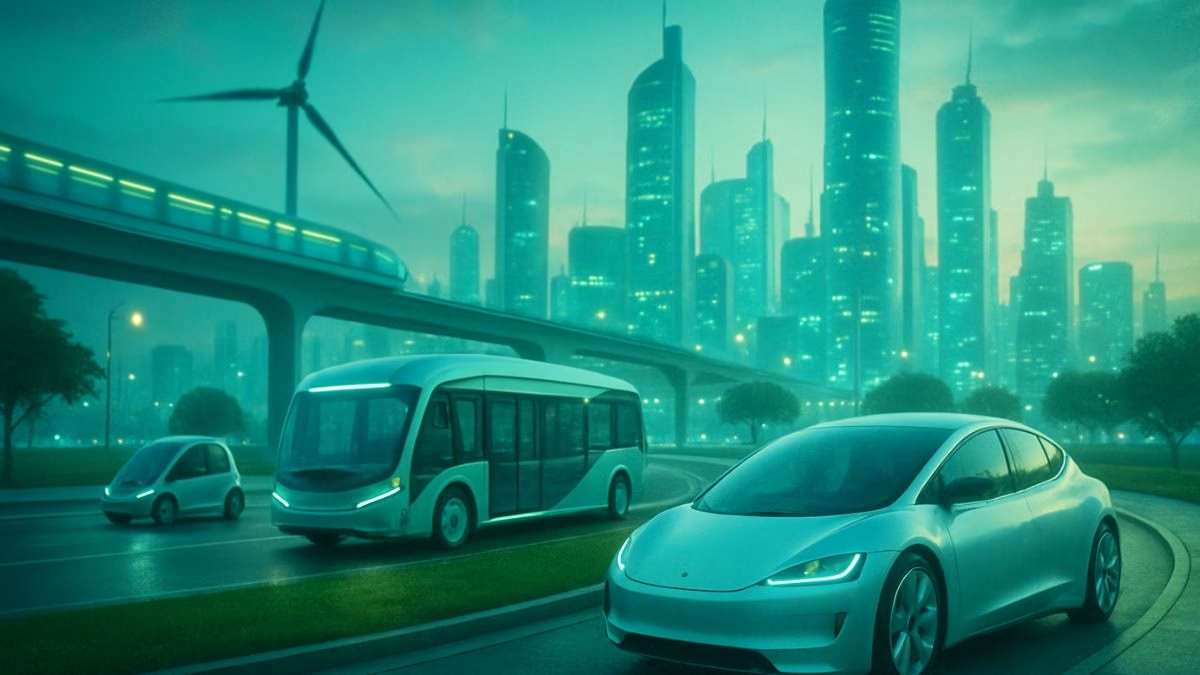How to Use This Lesson
Welcome to a forward-looking grammar lesson! To speak and write about the future with nuance and precision, you need more than just ‘will’ and ‘going to’. This lesson explores the sophisticated grammatical structures used to discuss future possibilities, predictions, and plans.
Here’s your roadmap to success:
- First Read: Journey through the text below on “The Future of Sustainable Transportation.” Absorb the vision and the technological concepts.
- Second Read & Analysis: Re-read the article with our “Grammar Analysis” as your co-pilot. We’ll pause to examine the advanced grammar that gives the text its formal, speculative, and persuasive power.
- Practice: Take these structures for a test drive! Try to form your own sentences about the future using the grammar we discuss. Active practice is the fastest route to mastery.
Let’s look to the future.
Imagining Tomorrow: Charting the Future of Sustainable Transportation
The transition to sustainable transport is no longer a fringe movement; it is a global imperative gaining momentum. While today’s landscape is dominated by the rise of electric vehicles and the expansion of cycling networks, the horizon of tomorrow promises transformations that are far more radical. Notwithstanding the considerable technological and financial hurdles that lie ahead, the trajectory is set towards a future of mobility that is intelligent, autonomous, and seamlessly integrated. The question is not if, but how and when these futuristic concepts will become our daily reality. By 2050, it is projected that engineers will have been working for decades to perfect these systems.
A cornerstone of this future is the concept of autonomous vehicles (AVs). The idea of self-driving cars, once the realm of science fiction, is now a tangible goal for countless tech giants and automotive manufacturers. Should this technology become mainstream, it could fundamentally redefine our relationship with personal transport. Proponents envision a world with drastically fewer accidents, as human error is removed from the driving equation. Furthermore, optimized, computer-controlled driving could eliminate traffic jams, leading to smoother flows and significant energy savings. By the time AVs are fully deployed, we will have completely rethought the design of our urban interiors, potentially converting vast areas of parking into green spaces or housing.
However, the future isn’t just about smarter individual cars; it’s about integrated mobility systems. Imagine a single app on your phone that plans the most efficient route for any journey, combining autonomous ride-sharing services, high-speed public transit, and last-mile solutions like e-scooters or bike-sharing. This is the vision of ‘Mobility as a Service’ (MaaS). Were we to embrace MaaS on a city-wide scale, the very notion of private car ownership could become obsolete for many urban dwellers. This would represent a monumental shift, freeing up citizens from the burdens of insurance, maintenance, and parking. The data generated by such a system, which would be anonymized to protect privacy, could provide urban planners with an unprecedented understanding of movement patterns, allowing for continuous, data-driven optimization of the entire network.
Looking further ahead, we encounter even more ambitious innovations. High-speed transit systems like the Hyperloop, promising to transport passengers in pods through low-pressure tubes at airline speeds, could shrink continents. Despite its almost fantastical nature, the concept is being actively developed by several competing firms. In the realm of aviation, the industry faces immense pressure to decarbonize. Had it not been for recent breakthroughs in battery density and electric motor efficiency, the prospect of electric short-haul flights would have remained a distant dream. Now, it is a question of scaling and certification. By the end of this decade, we will likely have seen the first commercial electric passenger flights, a truly remarkable milestone.
Of course, this gleaming future is not a foregone conclusion. Issues of cybersecurity in interconnected transport networks, ethical programming for autonomous vehicles (the ‘trolley problem’ on a mass scale), and ensuring equitable access to these new technologies for all socioeconomic groups are profound challenges that must be addressed. The solutions developed to overcome these obstacles will be as important as the technologies themselves. The path forward requires not just brilliant engineering, but also thoughtful policy-making and a robust public discourse. The future of sustainable transportation, a goal worth striving for despite the difficulties, is one that we must build with intention, foresight, and a shared commitment to a cleaner, safer, and more connected world.
Grammar Analysis: Let’s Break It Down
That text was packed with speculation and future-gazing, all supported by some very polished grammar. Let’s pull over and inspect these powerful structures.
1. Inverted Conditionals (a highly formal alternative to ‘if’)
- Example from the text: “Should this technology become mainstream, it could fundamentally redefine our relationship…”
- What is it? This is a very formal and elegant way of stating a first conditional (if + present, … will/can/may/could + verb). Instead of starting with ‘if’, you start with ‘Should’, followed by the subject and the base form of the verb.
- Let’s analyze:
- Standard form: “If this technology becomes mainstream…”
- Inverted form: “Should this technology become mainstream…” (Notice ‘become’, not ‘becomes’!). This structure sounds more hypothetical and polished, making it perfect for formal essays or presentations.
- Another example from the text: “Were we to embrace MaaS…, the very notion… could become obsolete…”
- This is an inversion for the second conditional (if + past, … would/could/might + verb). The standard form is: “If we embraced MaaS…” The inversion Were + subject + to + verb is even more formal and hypothetical.
- And one more! “Had it not been for recent breakthroughs…, the prospect… would have remained a distant dream.”
- This is a third conditional inversion (if + past perfect, … would/could/might + have + past participle). Standard form: “If it had not been for…” This structure, Had + subject + (not) + past participle, is fantastic for discussing how a past event changed a subsequent past outcome.
2. Future Perfect & Future Perfect Continuous (for looking back from the future)
- Example from the text: “…by the time AVs are fully deployed, we will have completely rethought the design of our urban interiors…”
- What is it? The Future Perfect (will have + past participle) is used to talk about an action that will be completed before a specific point in the future.
- Let’s analyze:
- The future point is “by the time AVs are fully deployed.” The action of “rethinking” will be finished before or at that time. It projects us into the future to look back at a completed action.
- Another example from the text: “…engineers will have been working for decades to perfect these systems.”
- This is the Future Perfect Continuous (will have been + -ing). It’s used to emphasize the duration of an action up to a certain point in the future. The focus isn’t just that the work will be done, but that it will have been ongoing for a long time (‘for decades’).
3. Clauses of Concession (for acknowledging counter-arguments)
- Example from the text: “Notwithstanding the considerable technological and financial hurdles…, the trajectory is set…”
- What is it? Clauses of concession are used to acknowledge a point that might challenge your main argument. It shows you’ve considered other perspectives, which makes your own argument stronger.
- Let’s analyze:
- Notwithstanding is a very formal synonym for despite or in spite of. It means “even though these hurdles exist.” By stating this upfront, the writer shows they are realistic, but still confident in their main point (the trajectory is set).
- Another example: “Despite its almost fantastical nature, the concept is being actively developed…”
- This is a more common but still very effective structure. It acknowledges the “fantastical nature” of Hyperloop before pivoting to the reality of its development.
- Common Mistake: Using ‘despite of’ or ‘in spite of that’. It’s despite + noun phrase, or in spite of + noun phrase. Or although + clause (subject + verb).
Let’s Sum Up!
Fantastic focus! Today, you’ve explored the grammar of the future:
- Inverted Conditionals: For creating formal, sophisticated ‘if’ statements with Should, Were, and Had.
- Future Perfect Tenses: To talk about actions that will be completed or ongoing up to a future point in time.
- Clauses of Concession: To strengthen your arguments by acknowledging opposing points with words like Despite and Notwithstanding.
Mastering these structures allows you to discuss future possibilities with the kind of nuance and formality expected in high-stakes exams and professional environments. Make it a goal to use one of these in your next piece of writing. The future of your English is bright!










0 Comments